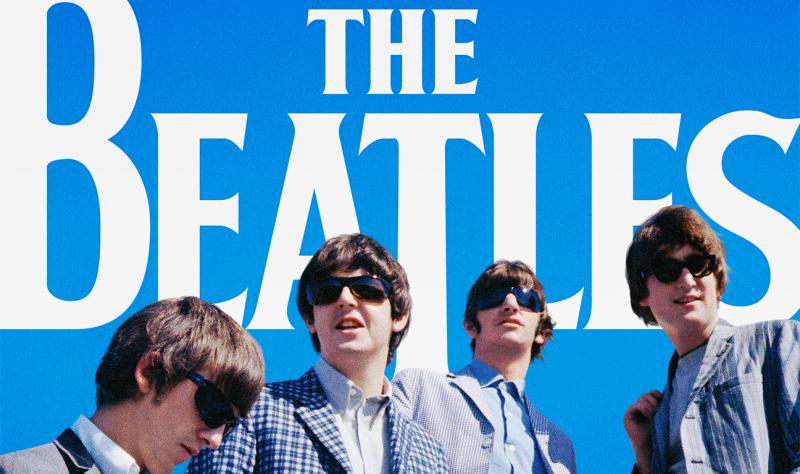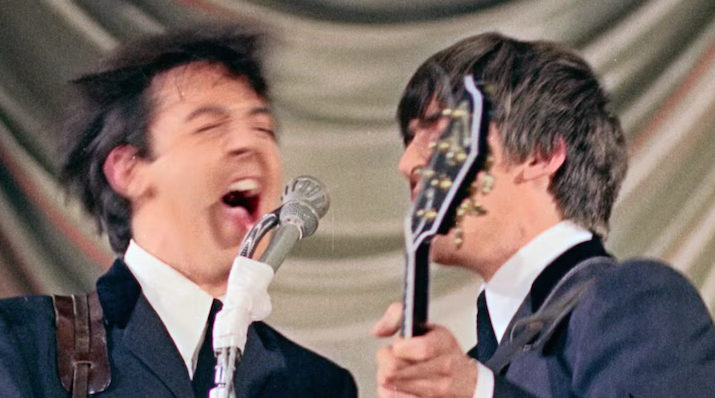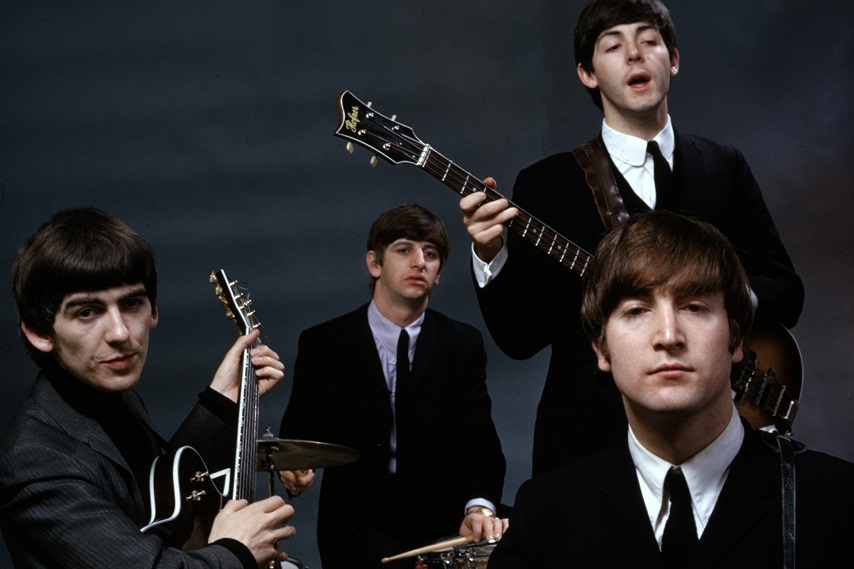The Beatles: Eight Days a Week - The Touring Years | reviews, news & interviews
The Beatles: Eight Days a Week - The Touring Years
The Beatles: Eight Days a Week - The Touring Years
Is there anything new to say about the Beatles? Amazingly, yes. Plus there's ravishingly restored footage from Shea Stadium

It could be a book, film, TV or radio piece, essay or exhibition. If it’s about or based on The Beatles, the question is always the same: how on earth can anything new be said? In the case of Ron Howard’s Eight Days a Week: The Touring Years, surprisingly quite a lot, is the answer.
Factually, there’s little with which the Apollo 13 and A Beautiful Mind director can grab even the most noddingly acquainted. Four boys from very modest backgrounds test themselves as a band in the early 1960s in Europe’s raciest city (Hamburg), get noticed in a scuzzy Liverpool basement by a posh shopkeeper (Brian Epstein), record in one day their first album (Please Please Me) with the help of a sensible, critical man on the button (George Martin), then play the same stuff, and more, live: first in the UK and Europe, then the US.
By 1965 and four LPs later, the erstwhile scruffs, now in suits, are the biggest music act the world has ever known. Over half a century on, whatever comparison you might seek, they remain so. The story of The Beatles as performers is like no other in history.
That concept Howard has grasped – no prizes for it – but what he has also done so well is in terms of production and presentation: an unequivocal five stars. Kicking off the drama with “She Loves You” in Manchester in 1963 in vibrant colour brings the group right back to life in a manner that the usual grainy black and white, blurred and shaky, never did or could. Kerr-pow: you’ve got The Beatles (The Beatles!) a few feet away from you.
 Even the black and white, much of it restored and polished for the film – as is the soundtrack, engineered by among others George Martin’s son Giles – now packs a punch: an outing for “I Saw Her Standing There” in Washington DC in 1964, during The Beatles’ first stint in America, seems to have been recorded yesterday. Ringo Starr drums with a heft and precision you never thought existed.
Even the black and white, much of it restored and polished for the film – as is the soundtrack, engineered by among others George Martin’s son Giles – now packs a punch: an outing for “I Saw Her Standing There” in Washington DC in 1964, during The Beatles’ first stint in America, seems to have been recorded yesterday. Ringo Starr drums with a heft and precision you never thought existed.
Enhancement is the main thrust of the film: refocusing, revitalising, and reminding us, with lots of clever digital tweaking (or “jiggery-pokery” as John Lennon once described Martin’s innovative technical prowess), how powerful and matchlessly charismatic they were; George Harrison’s especially floppy hair throughout is almost the star of the film. Plenty of TV footage from venues across the world survives: Howard and his researchers have scoured everything, from concerts to press conferences, and the result at the very least is satisfyingly informative.
They’ve also gone after bootleg film, snatched by surviving fans (few of whom today can be under 65) on Super-8. This goes notably for images from Candlestick Park, San Francisco, on 29 August 1966, the last time the quartet played in public anywhere. If watching The Beatles waving goodbye to their deranged audience, unwitting of the band’s imminent disappearance from the stage for good, isn’t historic, I don’t know what is.
Howard has also understood that the story of the touring insanity is largely an American one. Britain’s teenage girls erupted in 1963 with a self-abandon new to the species. A year later America’s equivalents, and as becomes increasingly clear in the film America as a whole, went utterly berserk, to points of danger and violence. Miami journalist Larry Kane, who followed The Beatles everywhere across the States, recalls the pandemonium with a look on his face today as if he’s just witnessed World War Three.
Other, more surprising, talking heads include Sigourney Weaver, who was at a famous Hollywood Bowl gig in 1964 – and there she is in startling black and white as a lissom, adoring 15-year-old, “in love with John”. Whoopi Goldberg remembers how completely universal they seemed, friendly, “neutered” – “and I’m black”.
 Paul and Ringo also have their slots, without which the film might feel rather haunted, or off-target. Commentary by Richard Curtis (nine when The Beatles quit touring) and Eddie Izzard (four) is offered, needlessly I think, to guarantee that TV- and Hugh Grant-watching Brits of a certain age – i.e. under 40 – can be drawn into the story without feeling they’re being taken back to the 1930s.
Paul and Ringo also have their slots, without which the film might feel rather haunted, or off-target. Commentary by Richard Curtis (nine when The Beatles quit touring) and Eddie Izzard (four) is offered, needlessly I think, to guarantee that TV- and Hugh Grant-watching Brits of a certain age – i.e. under 40 – can be drawn into the story without feeling they’re being taken back to the 1930s.
Alphas can be awarded for tackling civil rights and The Beatles’ insistence that an audience in Jacksonville in 1964 be unsegregated, and for interviews with Elvis Costello and author Jon Savage, who provide intelligent glosses on the music, necessarily, over and beyond the chaos of touring. Gammas for mentioning cannabis just once and LSD – the single-most important influence on the four in 1965-6 – not at all. Nor does the awkward topic of the dreadfully disabled being wheeled backstage for some kind of mad, miracle “Beatles cure” get a look-in. It should.
Shea Stadium in August 1965 was the biggest show The Beatles ever did, and the restored TV footage of that pops up as a footnote to Howard’s film. Quite a lot of the half-hour has long been available on YouTube but seeing it here, properly edited and licensed, is a total joy. Virtually none of the sound is original – The Beatles overdubbed the Shea songs in January 1966 before the programme was broadcast a few weeks later (and then in Britain never again) – but it is worth sticking around for, as it’s the most substantial stretch of Beatles live there is.
Or almost. After the touring story, two tracks, “Don’t Let Me Down” and “I’ve Got a Feeling”, are dropped in from the extraordinary rooftop concert (not, in fact, an official concert in any way at all) of January 1969, in Savile Row. These come from the final Beatles film, Let It Be, released a few months after they’d broken up. As far as I know, it has not been screened anywhere since the early 1970s.
The Beatles’ company Apple Corps have Let It Be – this I do have on the best authority – in hand. We will see it again one day. If the quality throughout is anything like these digitally enhanced and cleaned-up few minutes in Eight Days a Week, the story of the group live will be magnificently complete on screen. Even on the precipice, before their immolation began in spring 1969, the four were smiling and relishing their wonderful work together. Howard has put these scenes in to tantalise us: when will Let It Be come?
For the moment it is enough for him to remind us, as if we need reminding at this stage of his achievement, that The Beatles were and remain unalterably the best in the world.
- The Beatles: Eight Days a Week - The Touring Years is released on 15 September. The Shea Stadium concert footage will also be shown with it
- Read more about The Beatles on theartsdesk
Overleaf: watch the trailer to The Beatles: Eight Days a Week
Add comment
The future of Arts Journalism
You can stop theartsdesk.com closing!
We urgently need financing to survive. Our fundraising drive has thus far raised £49,000 but we need to reach £100,000 or we will be forced to close. Please contribute here: https://gofund.me/c3f6033d
And if you can forward this information to anyone who might assist, we’d be grateful.

Subscribe to theartsdesk.com
Thank you for continuing to read our work on theartsdesk.com. For unlimited access to every article in its entirety, including our archive of more than 15,000 pieces, we're asking for £5 per month or £40 per year. We feel it's a very good deal, and hope you do too.
To take a subscription now simply click here.
And if you're looking for that extra gift for a friend or family member, why not treat them to a theartsdesk.com gift subscription?

Comments
Not only is this so
Not only is this so ignorant,ridiculous,and false on a creative and musical level,but on their personal level too. I guarantee true genuine boy bands don't have groupies.
The Beatles had sex with *tons* of young women groupies,many who were just teen girls especially during their touring years of 1963-1966 ironically they did this the most during the joke fake cleaned up image Brian Epstein created for them in their early days.In reality they were like pimps playing the part of priests! It's no coincidence that in The Beatles Anthology video series that Paul,George and Ringo made,the story that is reported of The Beatles being thrown out of a US hotel in August 1965 because Paul was found in his hotel bedroom with an underage girl, that is included in the first great Beatles documentary from 1982 The Complete Beatles which none of them had any involvement making,is completely left out of The Beatles Anthology.And it's very obvious that Ron Howard left all of this out of his new Beatles documentary too.
Paul McCartney also said in Hunter Davies 1968 first edition of the only authorized Beatles biography called,The Beatles, that he had sex at age 15 with a girl who was older and bigger than him,and most 15 year old boys weren't having sex in 1957,and he said he bragged about it to his classmates the next day and that he was the first one in his class to have sex.Paul also said in this book,that he would go into strip clubs at only 13 and he was the lad in his class that drew nude women.He also got another girl who was his girl friend,pregnant when he was 17 and she was 16,and Paul's father and her parents wanted them to get married but she had a miscarriage.
Hunter Davies says in his 1985 update of his Beatles biography, that The Beatles were no different from any other rock band when it came to groupies and he said they just had more to chose from. He said it was up to the road manager to say to these young women,you,you and you 5 minutes later which is really sexist and disgusting but it's totally typical for every rock band which is what they always were.
Are you a loony, perhaps?
Are you a loony, perhaps?